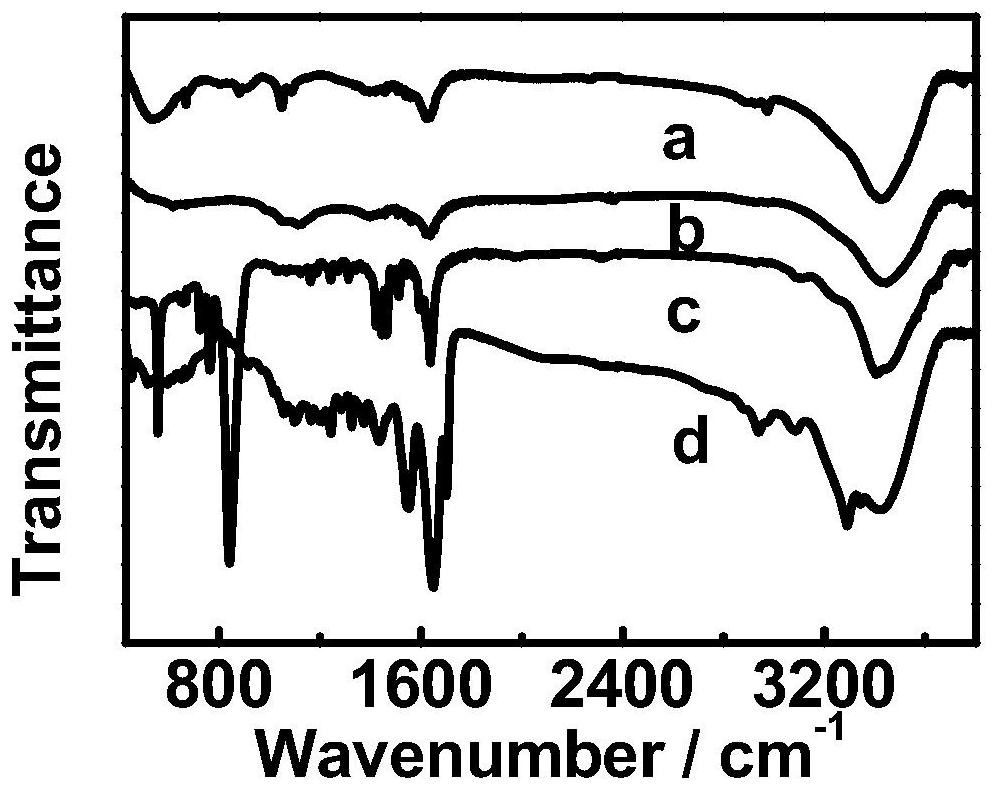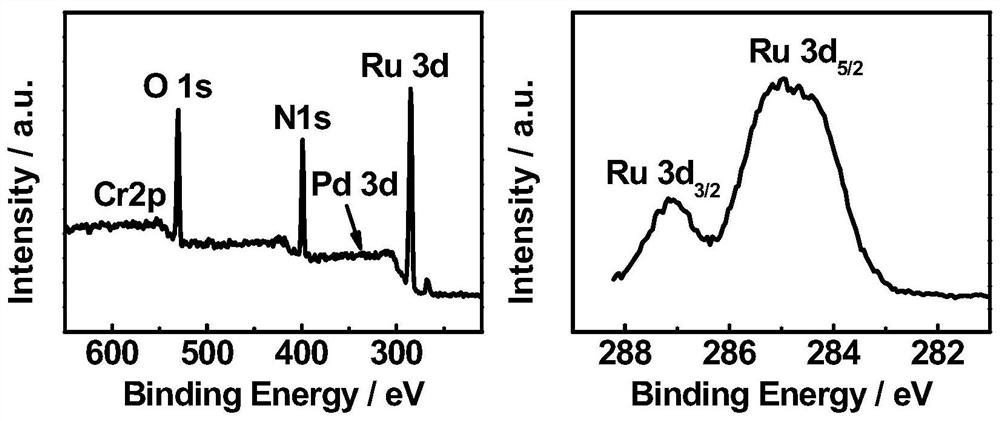Preparation method of electrochemiluminescence nano illuminant based on aminated bipyridyl ruthenium
A luminescent body and glutamic acid technology, applied in chemiluminescence/bioluminescence, chemical instruments and methods, and electrochemical variables of materials, etc., can solve problems such as difficult solid-state sensing platform, easy aggregation of water phase, and low luminous efficiency of ECL , to achieve the effect of reducing the intensity leakage of illuminants
- Summary
- Abstract
- Description
- Claims
- Application Information
AI Technical Summary
Problems solved by technology
Method used
Image
Examples
Embodiment 1
[0026] A Ru(bpy)-NH based 2 The preparation method of the ECL luminescent body, including the synthesis of Ru / Pd NSs@MIL-101, the synthetic route is as follows figure 1 As shown, the specific steps are as follows:
[0027] Step 1, disperse 0.8g of chromium nitrate nonahydrate, 0.294g of glutamic acid and 0.2g of sodium hydroxide in 15mL of water in one pot. After the dissolution is complete, transfer it to a 25mL reactor and react at 160°C for 12 hours. The resulting solution is passed through MIL-101(Cr) was obtained by centrifuging and washing with a mixed solution of water and methanol at a volume ratio of 1:1, followed by activation at 200°C for 6 hours.
[0028] Step 2, disperse 0.1g MIL-101(Cr) in 20mL water, ultrasonically disperse in ultrapure water, slowly add 0.06g palladium chloride powder to it under magnetic stirring, the mass ratio of the two is 5:3, after stirring for 4 hours Centrifuge to remove unbound palladium chloride. The obtained precipitate was redisp...
Embodiment 2
[0031] A Ru(bpy)-NH based 2 The preparation method of the ECL luminescent body, including the synthesis of Ru / Pd NSs@MIL-101, the synthetic route is as follows figure 1 As shown, the specific steps are as follows:
[0032] Step 1, disperse 0.8g of chromium nitrate nonahydrate, 0.294g of glutamic acid and 0.2g of sodium hydroxide in 10mL of water in one pot. After the dissolution is complete, transfer it to a 50mL reactor and react at 200°C for 18 hours. The resulting solution is passed through MIL-101(Cr) was obtained by centrifuging and washing with a mixed solution of water and methanol at a volume ratio of 1:1, followed by activation at 160° C. for 4 hours.
[0033]Step 2, disperse 0.1g MIL-101(Cr) in 10mL water, ultrasonically disperse in ultrapure water, slowly add 0.1g palladium chloride powder to it under magnetic stirring, the mass ratio of the two is 1:1, after stirring for 6 hours Centrifuge to remove unbound palladium chloride. The resulting precipitate was redis...
Embodiment 3
[0036] A Ru(bpy)-NH based 2 The preparation method of the ECL luminescent body, including the synthesis of Ru / Pd NSs@MIL-101, the synthetic route is as follows figure 1 As shown, the specific steps are as follows:
[0037] Step 1, disperse 0.8g of chromium nitrate nonahydrate, 0.294g of glutamic acid and 0.2g of sodium hydroxide in 5mL of water in one pot, transfer it to a 30mL reactor after the dissolution is complete, and react at 180°C for 14 hours. MIL-101(Cr) was obtained by centrifuging and washing with a mixed solution of water and methanol at a volume ratio of 1:1, followed by activation at 180° C. for 2 hours.
[0038] Step 2, disperse 0.1g MIL-101(Cr) in 15mL water, ultrasonically disperse in ultrapure water, slowly add 0.06g palladium chloride powder to it under magnetic stirring, the mass ratio of the two is 5:3, after stirring for 4 hours Centrifuge to remove unbound palladium chloride. The obtained precipitate was redispersed into 20mL water, added 0.1mL hydra...
PUM
 Login to View More
Login to View More Abstract
Description
Claims
Application Information
 Login to View More
Login to View More - R&D
- Intellectual Property
- Life Sciences
- Materials
- Tech Scout
- Unparalleled Data Quality
- Higher Quality Content
- 60% Fewer Hallucinations
Browse by: Latest US Patents, China's latest patents, Technical Efficacy Thesaurus, Application Domain, Technology Topic, Popular Technical Reports.
© 2025 PatSnap. All rights reserved.Legal|Privacy policy|Modern Slavery Act Transparency Statement|Sitemap|About US| Contact US: help@patsnap.com



